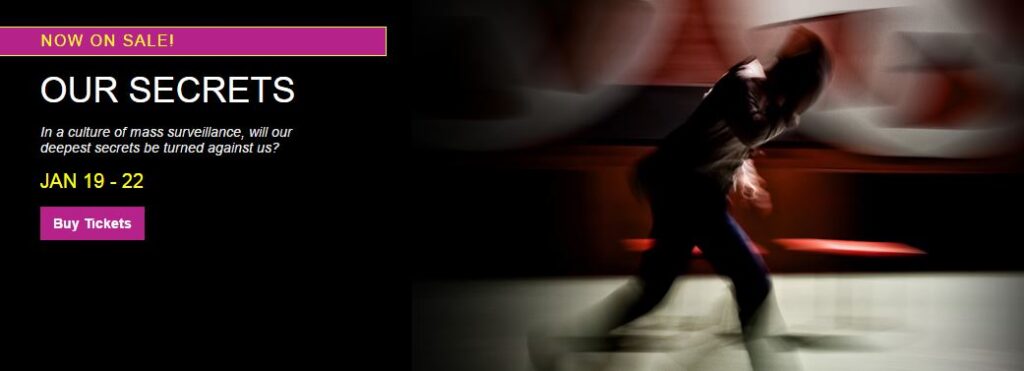Share This:
January 9, 2017 | Theatre,
Exploring the Hungarian dance house movement of Our Secrets
1980. Soviet-era Hungary. In a dance hall, a musician confesses his private sexual desire for his seven-year-old step-daughter. And his government is taping his every word. Under threat of being exposed as a pedophile, he is pressured into becoming a government informant which leads to the arrest and murder of his best friend, the head of an underground, anti-Communism newspaper. The plot of Our Secrets is intense, dark, and relevant to current political situations across the globe. But the details of this story are purposely specific to the cultural Dance House movement, aka the Táncház scene– a grassroots phenomenon that developed in Hungary in the seventies and eighties which provides a rich background of music and dance to create a painstakingly accurate reality that Our Secrets takes place within.

The origins of Táncház, a term derived from the Transylvanian tradition of hosting dances in people’s homes, traces back to 1973, where the first public dance enjoyed “the sort of crowd you’d expect for a rock concert,” reported Songlines.co.uk in their profile of the movement, “People were climbing in through the toilet windows, in a rush to hear completely traditional Hungarian folk music!” These songs were in direct contrast to the “hackneyed labour movement songs” that were popular at the time and were received in a revelatory manner by Hungarian youth culture. Just as young people in Cambridge, MA and Greenwich Village in NYC created an American folk music revival in the late fifties and early sixties, Táncház provided a way for young people to embrace the past and make it new and relevant to their generation in the seventies and eighties. At the time, the music of Eastern Europe had been “hijacked by state ensembles performing sanitized music with costumes and choreographed dance routines.” Also like Cambridge/Greenwhich’s folk revival, the Táncház scene was at first wholly removed from politics all together, instead primarily serving artistic and social needs of the culture. For example, the events were often “organized by eligible bachelors…[to] serve the purpose of dancing together with and becoming acquainted with eligible girls, encouraging courtship and locally appropriate sociability.” (Mary Taylor: The Hungarian Dance-House Movement) The dress was casual, gone were the elaborate costumers, now replaced with simple blue jeans and a t-shirt.
The music itself is often represented by instruments like violins, violas, and double bass. It is often fast paced and extremely danceable. The recorded record of the movement and style can be heard in the albums of acts like Sebő Ensemble, Muzsikás, The Ökrös Ensemble, Tükrös (don’t miss the playlists we’ve assembled, linked at the end of this article).
As the movement grew, the government’s interest was piqued. In Tamás Jászay’s essay appearing in the program for Our Secrets, it’s explained how things proceeded: “the government then reproduced and represented in state-run cultural houses. Communist Hungary’s dictatorship labeled the cultural acts and their corresponding community events throughout the country as either ‘banned,’ ‘tolerated’ or ‘supported.’ The folk-music scene was labeled ‘supported’ by the authoritarian government, therefore becoming a supposedly safe space for anti-Communist organizers to operate clandestinely, with little government oversight or interference to disrupt communications.” This is where the plot of Our Secrets and the historical facts of the dance house movement come together to present the story of the play. It is at a dance house that the character of folk music collector István Balla Bán feels as if he’s in a safe space to make his awful confession about his sexual depravity. It is at a dance house that his friendship with the secret leader of anti-Communism newspaper is leveraged by the government to turn informant. It thus becomes apparent: the government has only created the illusion of a safe space at dance halls to best monitor possible enemies of the state. Again, this is not unlike the FBI’s surveillance and infiltration of multiple American artistic and counterculture organizations of the sixties. “The basis for their [Bela Pinter and Company’s] productions is the everyday contemporary Hungarian reality,” writes one dramaturg about the creators of Our Secrets, and the contemporary reality, as suggested by the events of the production, is indeed grim. It takes a particularly ruthless and cynical government to take a joyous artform which citizens turn to for comfort and connection and then transform it into a tool for control.
It’s not just Táncház dance hall music that appears in Our Secrets, Hungarian Underground music of the eighties is also represented as well to present a full, well-rounded picture of the time period. Before enjoying this rare opportunity to see Bela Pinter and Company’s work here in Boston, feel free to immerse yourself in both the Táncház dance hall music playlist and the 80’s Hungarian Underground music playlist we’ve compiled to provide audience members with audio context of the incredible production that awaits them.

Our Secrets – JAN 19 – 22 at the Emerson/Paramount Center. Tickets are on sale now.
-Ryan H. Walsh





Leave a Reply